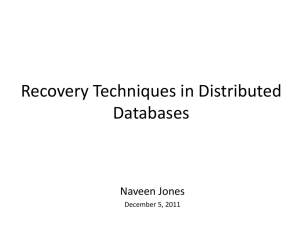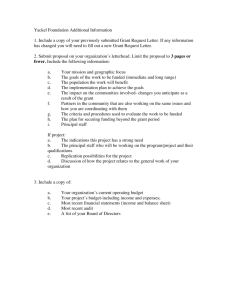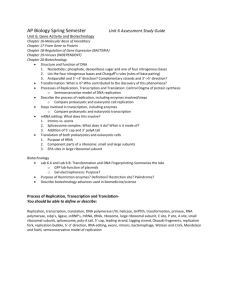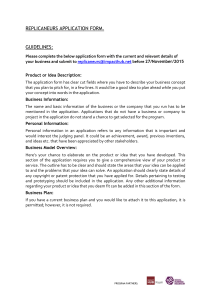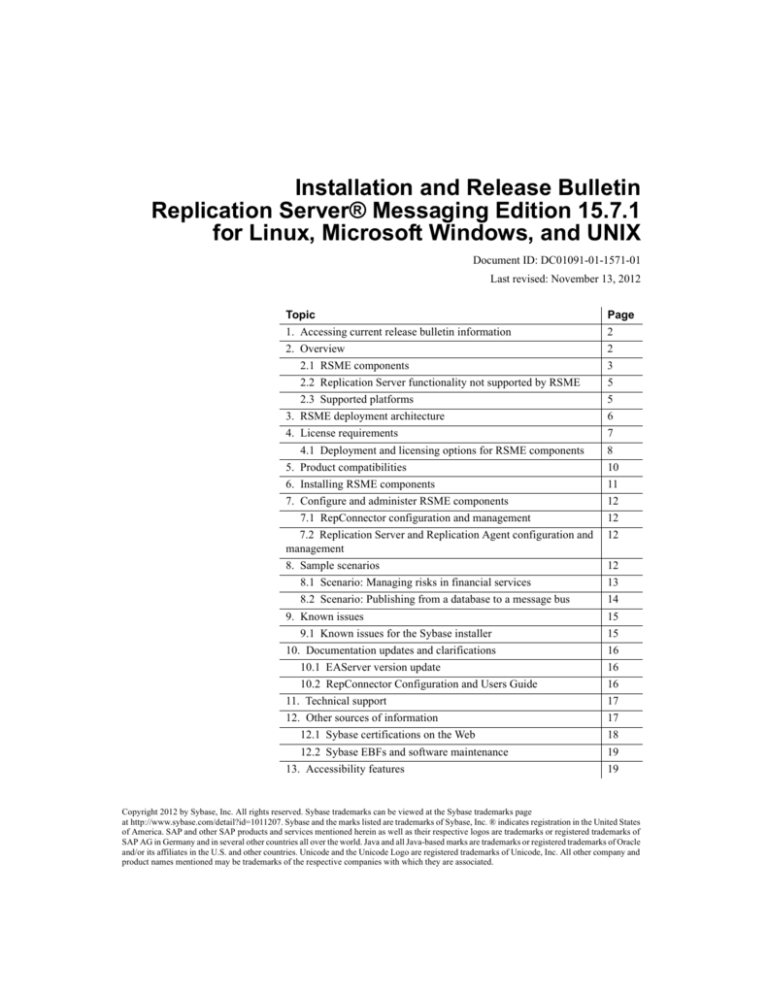
Installation and Release Bulletin
Replication Server® Messaging Edition 15.7.1
for Linux, Microsoft Windows, and UNIX
Document ID: DC01091-01-1571-01
Last revised: November 13, 2012
Topic
1. Accessing current release bulletin information
Page
2
2. Overview
2.1 RSME components
2
3
2.2 Replication Server functionality not supported by RSME
2.3 Supported platforms
5
5
3. RSME deployment architecture
4. License requirements
6
7
4.1 Deployment and licensing options for RSME components
5. Product compatibilities
8
10
6. Installing RSME components
7. Configure and administer RSME components
11
12
7.1 RepConnector configuration and management
7.2 Replication Server and Replication Agent configuration and
management
8. Sample scenarios
12
12
8.1 Scenario: Managing risks in financial services
8.2 Scenario: Publishing from a database to a message bus
12
13
14
9. Known issues
9.1 Known issues for the Sybase installer
15
15
10. Documentation updates and clarifications
10.1 EAServer version update
16
16
10.2 RepConnector Configuration and Users Guide
11. Technical support
16
17
12. Other sources of information
12.1 Sybase certifications on the Web
17
18
12.2 Sybase EBFs and software maintenance
13. Accessibility features
19
19
Copyright 2012 by Sybase, Inc. All rights reserved. Sybase trademarks can be viewed at the Sybase trademarks page
at http://www.sybase.com/detail?id=1011207. Sybase and the marks listed are trademarks of Sybase, Inc. ® indicates registration in the United States
of America. SAP and other SAP products and services mentioned herein as well as their respective logos are trademarks or registered trademarks of
SAP AG in Germany and in several other countries all over the world. Java and all Java-based marks are trademarks or registered trademarks of Oracle
and/or its affiliates in the U.S. and other countries. Unicode and the Unicode Logo are registered trademarks of Unicode, Inc. All other company and
product names mentioned may be trademarks of the respective companies with which they are associated.
1. Accessing current release bulletin information Replication Server Messaging Edition 15.7.1
1. Accessing current release bulletin information
A more recent version of this release bulletin may be available on the Web. To
check for critical product or document information added after the product
release, use the Sybase® Product Documentation Web site.
Accessing release bulletins at the Sybase Product Documentation Web
site
1
Go to Product Documentation at http://www.sybase.com/support/manuals/.
2
Select a product.
3
Select a product version from the Document Set list.
4
From the list of individual documents, select the link to the release bulletin
for your platform. You can either download the PDF version or browse the
document online.
2. Overview
The primary goal of a messaging system is to manage communication across
heterogeneous systems enabling individuals throughout the enterprise to
efficiently access and share information. A messaging solution must
seamlessly integrate with your other IT resources and scale to meet your
messaging needs, both now and in the future. The Replication Server®
Messaging Edition (RSME) provides a messaging solution that addresses these
challenges.
RSME captures transactions (data changes) in various databases such as
Adaptive Server® Enterprise (ASE) and other non-Sybase databases such as
Oracle, IBM DB2, and Microsoft SQL Server, and delivers them as events to
external applications, either directly or through a message bus, in real time.
RSME:
•
Provides access to a variety of heterogeneous data sources.
•
Captures and propagates real-time events in data sources to time-critical
applications.
•
Provides adapters for integrating with non-Sybase message providers such
as IBM WebSphere MQ, TIBCO RV, Sonic MQ, or Sybase certified J2EEcompliant Java Message Service (JMS).
See the complete list of supported messaging providers at
http://upc.sybase.com/. Select RepConnector™ from the product list in
Search by Base Product.
2
Release Bulletin for Linux, Microsoft Windows, and UNIX
Replication Server Messaging Edition 15.7.1
2. Overview
•
Synthesizes analytical information with data from your organization’s
operational processes to provide just-in-time information.
•
Enables applications to be resilient to network failure.
2.1 RSME components
The RSME includes these components:
•
RepConnector 15.0.2 ESD #6
•
Replication Server 15.7.1
•
Replication Agent™ 15.7.1
Note If your primary database is Adaptive Server®, then Replication
Agent is not required to be installed. Additionally, if you already have
BEA Weblogic version 10 installed, then installing EAServer is optional.
•
EAServer 6.3.1
2.1.1 RepConnector
RepConnector provides a nonpolling, nontrigger-based solution to database
integration, building on the Replication Server noninvasive system to push
database transactions into a traditional integration environment.
RepConnector provides adapters for sending messages to TIBCO, IBM MQ,
SonicMQ, or Sybase certified J2EE-compliant JMS messaging system. It can
also send messages to virtually any other user or application.
RepConnector:
•
Delivers database events and metadata from Replication Server to the
configured destination
•
Follows transactional behavior
•
Manages connections using:
•
RepConnector Manager, which is a GUI in the Eclipse framework
•
ratool, which is a command line utility
•
Can group database events into a single transaction
•
Supports binary datatypes
•
Parses replication events and generates XML documents
Release Bulletin for Linux, Microsoft Windows, and UNIX
3
2. Overview
Replication Server Messaging Edition 15.7.1
•
Transforms incoming database events into XML messages, and routes
them into configured message queues
•
Can transform incoming database events into their application-specific
format
•
Detects message events and routes them to database tables
•
Supports EAServer 6.3.1 as well as BEA WebLogic 10.0 application
servers
Note RepConnector does not support all Replication Server 15.7.1
functionality. For more detailed information, see “Replication Server
functionality not supported by RSME” on page 5.
See the RepConnector Configuration and Users Guide.
2.1.2 Replication Server
The Replication Server component is used for distribution and synchronization
of operational data in a heterogeneous replication environment. Replication
Server keeps data up to date in multiple databases so that you can access local
data instead of remote, centralized databases.
Replication Server works to distribute data over a network by:
•
Providing application developers and system administrators with a
flexible publish-and-subscribe model for marking data and stored
procedures to be replicated
•
Managing replicated transactions while retaining transaction integrity
across the network
See the Replication Server Administration Guide.
2.1.3 Replication Agent
The Replication Agent component captures transactions in a primary database
and sends them to a Replication Server for distribution to replicate targets.
Replication Agent extends the capabilities of Replication Server by allowing
non-Sybase data servers to act as primary data servers in a replication system
based on Sybase replication technology.
Replication Agent supports data replication from Oracle, Microsoft SQL
Server, and IBM DB2 UDB installed on UNIX, Linux, and Microsoft
Windows.
4
Release Bulletin for Linux, Microsoft Windows, and UNIX
Replication Server Messaging Edition 15.7.1
2. Overview
See the Replication Agent Administration Guide.
2.1.4 EAServer
EAServer is an application server that includes an integrated set of
development tools that you use to deploy Web applications that support highvolume traffic, dynamic content, and intensive online transaction processing.
EAServer provides a framework for deploying the middle-tier logic of
distributed component-based applications.
EAServer simplifies creating and administering Internet applications that
service thousands of clients simultaneously. EAServer components execute on
the middle tier between end-user client applications and remote databases.
EAServer provides efficient management of client sessions, security, threads,
third-tier database connections, and transaction flow, without requiring
specialized knowledge on the part of the component developer.
See the EAServer 6.3.1 documentation.
2.2 Replication Server functionality not supported by RSME
RSME supports Replication Server data manipulation language (DML)
statements (insert, delete, update). However, RSME does not support any
Replication Server applications that do not use DML statements such as high
volume adaptive replication (HVAR), Data Server Interface (DSI) bulk copyin, and dynamic SQL.
2.3 Supported platforms
Table 1 describes the compatible platform and operating system configurations
for RSME.
Table 1: RSME requirements
Platform
HP-UX Itanium
(32-bit and 64-bit)
IBM AIX
(32-bit and 64-bit)
Linux x86-64
(32-bit and 64-bit)
Operating system version
HP-UX Itanium 11.23 on HP-UX 11i version 2
IBM AIX 5.3
• Red Hat Enterprise Linux 4.0
• Red Hat Enterprise Linux 5.0
• SuSE Linux Enterprise Server SLES 9
• SuSE Linux Enterprise Server SLES 10
Release Bulletin for Linux, Microsoft Windows, and UNIX
5
3. RSME deployment architecture
Replication Server Messaging Edition 15.7.1
Platform
Operating system version
Solaris (SPARC)
(32-bit and 64-bit)
Solaris version 9 or 10
Note Replication Agent is only supported for Solaris (64-bit).
Microsoft Windows
(32-bit and 64-bit)
• Microsoft Windows XP Professional Service Pack 2 or later (x86)
• Microsoft Windows Server 2003
• Microsoft Windows Server 2008 R2
• Microsoft Windows Server 2008 (x64)
• Microsoft Windows 7 (x86)
• Microsoft Windows 7 Enterprise Server
• Microsoft Vista Enterprise
Note Replication Agent for Microsoft SQL Server is supported only on
Windows platform.
Refer to the individual product’s release bulletin for any patch level
information for your operating system. For a complete list of supported
operating systems, see the Sybase Platform Certification Web site at
http://certification.sybase.com/ucr/search.do.
3. RSME deployment architecture
Figure 1 shows a distributed system that contains the RSME components.
6
Release Bulletin for Linux, Microsoft Windows, and UNIX
Replication Server Messaging Edition 15.7.1
4. License requirements
Figure 1: RSME deployment architecture
4. License requirements
RSME uses the Sybase Software Asset Management (SySAM) licensing
mechanism for license administration and asset management tasks. After you
purchase RSME components, go to the Sybase Product Download Center
(SPDC) Web site at http://sybase.subscribenet.com to generate and download
the licenses. See the SySAM Users Guide.
Release Bulletin for Linux, Microsoft Windows, and UNIX
7
4. License requirements
Replication Server Messaging Edition 15.7.1
4.1 Deployment and licensing options for RSME components
Table 2 describes the deployment and license options for RSME components.
Table 2: Deployment and licensing options for RSME components
Component
Deployment and licensing options
RepConnector
• A SySAM served or unserved license is required.
Replication Server
• Installation is allowed on as many machines in the distributed environment for
which you have purchased licenses.
• A SySAM served or unserved license is required.
EAServer
• Installation is allowed on as many machines in the distributed environment for
which you have purchased licenses.
• Obtain the RSME .tgz file that contains the EAServer license, Replication Agent
license, and the Readme file from the SPDC Web site or the Getting Started CD.
• Installation is allowed on as many machines in the distributed environment for
which you have purchased licenses.
Note Select Advanced Edition (AE) as your product edition from the drop-down
list when installing EAServer 6.3.1.
Replication Agent
• Obtain the RSME .tgz file that contains the EAServer license, Replication Agent
license, and the Readme file from the SPDC Web site or the Getting Started CD.
• Installation is allowed on multiple machines that contain the supported database in
the distributed environment.
4.1.1 Installing static license for EAServer 6.3.1 Advanced Edition
Use this procedure to install the SYBASE_RSME_EAS.lic file that contains a
valid SySAM license for EAServer component in RSME 15.7.1.
1
Install EAServer 6.3.1 component from RSME 15.7.1, if not already
installed.
2
Stop EAServer if it is running.
3
Copy the included EAServer license file to these locations:
•
UNIX – $SYBASE/EAServer/licenses
•
Windows – %SYBASE%\EAServer\licenses
where $SYBASE or %SYBASE% is the installation directory where
EAServer 6.3.1 Advanced Edition is installed.
4
8
Restart EAServer.
Release Bulletin for Linux, Microsoft Windows, and UNIX
Replication Server Messaging Edition 15.7.1
5
4. License requirements
Verify the log file to confirm that EAServer has started in advanced mode.
In your log file, you should see lines similar to these lines:
2012-11-08 10:16:31.563 INFO main
[ApplicationServer:<servername>] Sybase Enterprise
Application Server 6.3.1.04 Advanced Edition
2012-11-08 10:16:31.565 INFO main
[ApplicationServer:<servername>] Server license
edition: Advanced Edition (AE), type:
CPU License (CP)
2012-11-08 10:16:31.568 INFO main
[ApplicationServer:<servername>] Server license
notice: Licensed for use with Sybase Replication
Server Messaging Edition (RSME) under the terms
specified in the RSME PSLT
4.1.2 Installing static license for Replication Agent 15.7.1
Use this procedure to install the SYBASE_RSME_RAX.lic file that contains a
valid SySAM license for Replication Agent component in RSME 15.7.1.
1
Install Replication Agent 15.7.1 component from RSME 15.7.1 release, if
not already installed.
2
Stop Replication Agent if it is running.
3
Copy the included Replication Agent license file to these location:
•
UNIX – $SYBASE/SYSAM-2_0/licenses
•
Windows – %SYBASE%\SYSAM-2_0\licenses
where $SYBASE or %SYBASE% is the installation directory where
Replication Agent 15.7.1 is installed.
4
Restart Replication Agent instance.
5
Verify the Replication Agent log file to determine if Replication Agent has
started successfully. You can access the Replication Agent log files at
these locations:
•
UNIX –
$SYBASE/RAX-15_5/instance_name/log/instance_name.log
•
Windows –
%SYBASE%\RAX-15_5\instance_name\log\instance_name.log
Release Bulletin for Linux, Microsoft Windows, and UNIX
9
5. Product compatibilities
Replication Server Messaging Edition 15.7.1
5. Product compatibilities
This section describes the compatibility of RSME components with nonSybase products.
RepConnector
Table 3 lists the enterprise messaging system versions supported by
RepConnector 15.0.2 ESD #6.
Table 3: Enterprise messaging systems compatible with RepConnector
Enterprise messaging system
Versions
TIBCO Rendezvous
TIBCO Enterprise for
TIBCO Active Enterprise
IBM WebSphere MQ/MQJMS
Sonic MQ
7.4.1
4.3.0 (JMS version)
4.1
6.0
7.5
See the complete list of supported enterprise messaging systems at
http://upc.sybase.com/. Select RepConnector from the product list in Search by
Base Product.
Replication Agent
Table 4 lists the primary database server versions supported by Replication
Agent 15.7.1
Table 4: Databases compatible with Replication Agent
Database
Versions
IBM DB2 Universal Database
Oracle Server
Enterprise Edition 9.1, 9.5, 9.7
10g (10.1, 10.2), 10g ASM, 10g RAC, 10g in 9i
compatibility mode, 11g (11.1, 11.2), 11g ASM, 11g
RAC
2005 Service Pack 2
Microsoft SQL Server
2008 R1 Service Pack 2 and 2008 R2 – support for
Microsoft SQL Server 2008 is limited to the same
features that are supported for Microsoft SQL
Server 2005. Replication Agent does not support the
features and datatypes introduced in Microsoft SQL
Server 2008.
Replication Agent requires a JDBC™ 3.0-compliant driver for the primary
data server. Table 5 lists the JDBC driver versions required to support
connectivity between Replication Agent 15.7.1 and the primary data server.
10
Release Bulletin for Linux, Microsoft Windows, and UNIX
Replication Server Messaging Edition 15.7.1
6. Installing RSME components
Table 5: Drivers compatible with Replication Agent
Driver
DB2 Universal Database
Administration Client
Versions
64-bit on Linux platform; 32-bit on Windows
platform only. Use version:
• 9.5 – for DB2 9.1 and 9.5
• 9.7 – for DB2 9.7
Oracle JDBC driver
• 10.2 for JDK 1.4 and 1.5
• 11.1 for JDK 1.5
• 11.2 for JDK 1.6
Note You can use any of these drivers with Oracle
version 10.1, 10.2, or 11.1. However, for Oracle
11.2, you must use Oracle JDBC 11.2 driver.
Microsoft SQL Server
JDBC driver
3.0
For Replication Server 15.7.1 and EAServer 6.3.1 product compatibilities, see
the release bulletins for the appropriate platforms for these two products.
6. Installing RSME components
Install each RSME component separately, following the instructions in each
product's installation guide.
Be aware of these considerations:
•
Before you install RepConnector 15.0.2 ESD #6, one of these application
servers must be installed and running on your local machine:
•
Sybase EAServer version 6.3.1 running with JDK 1.5
•
BEA WebLogic version 10.0 running with JDK 1.5
•
Install Replication Agent for Oracle on a machine from which it can
directly access the Oracle redo logs and the archived redo logs.
•
Install Replication Agent for Microsoft SQL Server on a machine from
which it can directly access the SQL Server transaction log files.
Release Bulletin for Linux, Microsoft Windows, and UNIX
11
7. Configure and administer RSME components
Replication Server Messaging Edition 15.7.1
7. Configure and administer RSME components
This section describes how to configure and administer the RSME
components.
7.1 RepConnector configuration and management
RepConnector Manager is a plug-in to the Eclipse framework that you can use
to manage RepConnector runtime component activity. You can run
RepConnector Manager on the local machine where the RepConnector runtime
component is installed, or on any remote machine that can access the machine
on which the RepConnector runtime component is installed. To access the
remote machine, verify that the HTTP connection to the application server on
which the RepConnector runtime component is deployed and running, is
available throughout the network. Use the RepConnector Manager to configure
the RepConnector connections.
See the RepConnector Configuration and Users Guide.
7.2 Replication Server and Replication Agent configuration and
management
Use the Replication Manager (RM) plug-in to manage and monitor Replication
Server and Replication Agent instances.
You can also configure, manage, and monitor a Replication Agent instance
using any Open Client™ application (such as isql) that is capable of
communicating with the Sybase Tabular Data Stream™ (TDS) protocol.
For more information on using Replication Manager, see the Replication
Manager online help.
Additionally, see the Replication Server Configuration Guide and the
Replication Agent Administration Guide.
8. Sample scenarios
This section shows through a variety of samples, various ways you can use
RSME components to meet the needs of your enterprise.
12
Release Bulletin for Linux, Microsoft Windows, and UNIX
Replication Server Messaging Edition 15.7.1
8. Sample scenarios
8.1 Scenario: Managing risks in financial services
A trading company wants to offer proactive notifications of changes to
customer data and securities data. For example, if the buy limit for a security
is reached, the company wants to immediately send this information to all
trading systems. The system that is currently in place must poll the securities
operational database, which introduces information lag, which in turn,
introduces the likelihood of credit limit breaches. The current implementation
does not allow the company lessen this risk, or to identify security breaches
early.
The current system periodically polls the database that holds credit limit
thresholds resulting in performance degradation to the operational systems.
The frequency of polling determines how quickly the trading company can
identify whether there is a credit-limit break.
The trading company wants to automatically prevent trading once a customer’s
credit limit has been reached. Polling the securities operational database is not
frequent enough to accomplish this goal
At various locations, customer and securities data are stored in Sybase
Adaptive Server Enterprise (ASE) and Oracle databases.
RSME pushes time-critical data from heterogeneous databases to the
messaging architecture, eliminating the information lags created by batch
updates or intermittent polling processes.
When a customer places a trade request, the trading company uses RSME to
send messages from their customer and securities databases to a message bus.
The trade request is read by a client application that computes credit risk. If the
credit limit is not reached, the customer trade is allowed. If the buy limit has
been reached, all trading systems connected to the message bus are
immediately notified to take the necessary precautionary measures.
The events, or messages are delivered to external applications in real time
through a message bus such as IBM WebSphere MQ or JMS.
Release Bulletin for Linux, Microsoft Windows, and UNIX
13
8. Sample scenarios
Replication Server Messaging Edition 15.7.1
Figure 2: RSME data flow
8.2 Scenario: Publishing from a database to a message bus
This scenario shows how you can use RSME to capture events from various
databases and publish the events in real time over a message bus. In Figure 3,
events are published from different database systems to a number of
applications. Inventory management is running on ASE. A customer
relationship management (CRM) application is running on an Oracle database,
and a manufacturing quality control system is running on IBM DB2.
In this configuration, a Sybase certified message bus can be used. A business
activity monitoring application requires real-time notification of critical events
from all three of the source databases. The customer event management
application enables the organization to notify customers proactively based on
critical events. The organization may also want to, for example notify
customers if they have been sent defective items as identified by the quality
control system. An operational data store is updated in real-time from all three
of the source systems.
14
Release Bulletin for Linux, Microsoft Windows, and UNIX
Replication Server Messaging Edition 15.7.1
9. Known issues
Figure 3: Publishing from any database to any message bus
9. Known issues
For known issues concerning RepConnector, Replication Agent, Replication
Server, and EAServer see the appropriate product and version release bulletin.
The known issues for Replication Server and Replication Agent below, are in
addition to those described in the individual product release bulletins.
9.1 Known issues for the Sybase installer
This section describes known issues with the Sybase installer that are not
specific to a particular data server type.
9.1.1 Cannot view text fields properly when using Hummingbird Exceed from
Windows
If you use Hummingbird Exceed from a Windows workstation to install
Replication Agent on a UNIX host, you might not be able to view all of the text
fields on the Sybase installer screens.
Workaround: Either use a native X-Windows session to run the Sybase
installer, or run it in console or silent mode. See the Replication Agent
Installation Guide.
Release Bulletin for Linux, Microsoft Windows, and UNIX
15
10. Documentation updates and clarifications
Replication Server Messaging Edition 15.7.1
9.1.2 Sybase Central fails to open after uninstalling Replication Agent
[CR #399954] Uninstalling Replication Agent removes the SYBASE system
environment variable. Consequently, Sybase Central™ cannot open.
Workaround: Redefine the SYBASE system environment variable.
10. Documentation updates and clarifications
RepConnector only supports Sybase certified J2EE-compliant JMS messaging
systems. Any reference in the RepConnector Configuration and Users Guide
that implies that RepConnector supports any J2EE-compliant JMS messaging
system is in error.
10.1 EAServer version update
All instances of EAServer version mentioned in these documents should read
as EAServer 6.3.1 as that is the EAServer version supported by RSME 15.7.1:
•
RepConnector 15.0.2 Release Bulletin
•
RepConnector 15.0.2 Installation Guide
•
RepConnector 15.0.2 Configuration and Users Guide
10.2 RepConnector Configuration and Users Guide
10.2.1 Chapter 1, “Overview”
Replace this text in the “Introduction” section:
RepConnector provides adapters for sending to TIBCO, IBM MQ,
SonicMQ, or any J2EE-compliant JMS messaging system. It can also send
messages to virtually any other user or application.
The corrected text is:
RepConnector provides adapters for sending messages to TIBCO, IBM
MQ, SonicMQ, or Sybase certified J2EE-compliant JMS messaging
system. It can also send messages to virtually any other user or application.
16
Release Bulletin for Linux, Microsoft Windows, and UNIX
Replication Server Messaging Edition 15.7.1
11. Technical support
10.2.2 Chapter 4, “Configuring RepConnector”
The text in the last Note of the “Configuring the RepConnector” section is
incorrect. The corrected text is:
Note To set the environment for the messaging system, you must modify the
%REPRA_HOME%\bin\repra_env.bat file on Windows, and
$REPRA_HOME/bin/repra_env.sh file on UNIX, where %REPRA_HOME%
or $REPRA_HOME is the RepConnector installation directory.
10.2.3 Chapter 7, “Customizing the Sender and Formatter Processors”
The text in the first paragraph of the “Customizing the sender processor”
section is incorrect. The corrected text is:
RepConnector has built-in senders that can post replication events to Sybase
certified JMS, TIBCO, and IBM MQ messaging systems. It also provides an
API for creating custom senders that can route replication events to anywhere
that is accessible to Java, such as e-mail applications, files, or printers.
11. Technical support
Each Sybase installation that has purchased a support contract has one or more
designated people who are authorized to contact Sybase Technical Support. If
you have any questions about this installation or if you need assistance during
the installation process, ask the designated person to contact Sybase Technical
Support or the Sybase subsidiary in your area.
12. Other sources of information
Use the Sybase Getting Started CD and the Sybase Product Documentation
Web site to learn more about your product:
•
The Getting Started CD contains release bulletins and installation guides
in PDF format. It is included with your software. To read or print
documents on the Getting Started CD, you need Adobe Acrobat Reader,
which you can download at no charge from the Adobe Web site using a
link provided on the CD.
Release Bulletin for Linux, Microsoft Windows, and UNIX
17
12. Other sources of information
•
Replication Server Messaging Edition 15.7.1
The Sybase Product Documentation Web site is accessible using a
standard Web browser. In addition to product documentation, you will find
links to EBFs/Maintenance, Technical Documents, Case Management,
Solved Cases, newsgroups, and the Sybase Developer Network.
To access the Sybase Product Documentation Web site, go to Product
Documentation at http://www.sybase.com/support/manuals/.
12.1 Sybase certifications on the Web
Technical documentation at the Sybase Web site is updated frequently.
Finding the latest information on product certifications
1
Point your Web browser to Technical Documents at
http://www.sybase.com/support/techdocs/.
2
Click Partner Certification Report.
3
In the Partner Certification Report filter select a product, platform, and
timeframe and then click Go.
4
Click a Partner Certification Report title to display the report.
Finding the latest information on component certifications
1
Point your Web browser to Availability and Certification Reports at
http://certification.sybase.com/.
2
Either select the product family and product under Search by Base
Product; or select the platform and product under Search by Platform.
3
Select Search to display the availability and certification report for the
selection.
Creating a personalized view of the Sybase Web site (including support
pages)
Set up a MySybase profile. MySybase is a free service that allows you to create
a personalized view of Sybase Web pages.
18
1
Point your Web browser to Technical Documents at
http://www.sybase.com/support/techdocs/.
2
Click MySybase and create a MySybase profile.
Release Bulletin for Linux, Microsoft Windows, and UNIX
Replication Server Messaging Edition 15.7.1
13. Accessibility features
12.2 Sybase EBFs and software maintenance
Finding the latest information on EBFs and software maintenance
1
Point your Web browser to the Sybase Support Page at
http://www.sybase.com/support.
2
Select EBFs/Maintenance. If prompted, enter your MySybase user name
and password.
3
Select a product.
4
Specify a time frame and click Go. A list of EBF/Maintenance releases is
displayed.
Padlock icons indicate that you do not have download authorization for
certain EBF/Maintenance releases because you are not registered as a
Technical Support Contact. If you have not registered, but have valid
information provided by your Sybase representative or through your
support contract, click Edit Roles to add the “Technical Support Contact”
role to your MySybase profile.
5
Click the Info icon to display the EBF/Maintenance report, or click the
product description to download the software.
13. Accessibility features
This document is available in an HTML version that is specialized for
accessibility. You can navigate the HTML with an adaptive technology, such
as a screen reader, or view it with a screen enlarger.
The HTML documentation has been tested for compliance with the U.S.
government Section 508 Accessibility requirements. Documents that comply
with Section 508 generally also meet non-U.S. accessibility guidelines, such as
the World Wide Web Consortium (W3C) guidelines for Web sites.
For a section 508 compliance statement for Sybase products, go to the Voluntary
Product Assessment Template at http://www.sybase.com/detail_list?id=52484
Note You might need to configure your accessibility tool for optimal use.
Some screen readers pronounce text based on its case; for example, they
pronounce ALL UPPERCASE TEXT as initials, and MixedCase Text as
words. You might find it helpful to configure your tool to announce syntax
conventions. Consult the documentation for your tool.
Release Bulletin for Linux, Microsoft Windows, and UNIX
19
13. Accessibility features
Replication Server Messaging Edition 15.7.1
For information about how Sybase supports accessibility, see Sybase
Accessibility at http://www.sybase.com/accessibility. The Sybase Accessibility
site includes links to information on Section 508 and W3C standards.
20
Release Bulletin for Linux, Microsoft Windows, and UNIX





